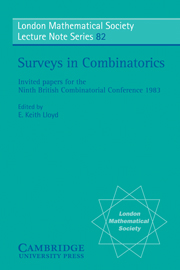Book contents
- Frontmatter
- Contents
- PREFACE
- GRAPHS AND INTERCONNECTION NETWORKS: DIAMETER AND VULNERABILITY
- THE FRIENDSHIP THEOREM AND THE LOVE PROBLEM
- MAXIMUM SETS IN FINITE PROJECTIVE SPACES
- QUASIGROUP IDENTITIES AND ORTHOGONAL ARRAYS
- BOUNDS ON PERMANENTS, AND THE NUMBER OF 1-FACTORS AND 1-FACTORIZATIONS OF BIPARTITE GRAPHS
- REDFIELD DISCOVERED AGAIN
- CHARACTERIZATIONS OF THE LIE INCIDENCE GEOMETRIES
- GL(n, C) FOR COMBINATORIALISTS
- IRREGULARITIES OF PARTITIONS: RAMSEY THEORY, UNIFORM DISTRIBUTION
- INDEX OF NAMES
- SUBJECT INDEX
GRAPHS AND INTERCONNECTION NETWORKS: DIAMETER AND VULNERABILITY
Published online by Cambridge University Press: 05 May 2013
- Frontmatter
- Contents
- PREFACE
- GRAPHS AND INTERCONNECTION NETWORKS: DIAMETER AND VULNERABILITY
- THE FRIENDSHIP THEOREM AND THE LOVE PROBLEM
- MAXIMUM SETS IN FINITE PROJECTIVE SPACES
- QUASIGROUP IDENTITIES AND ORTHOGONAL ARRAYS
- BOUNDS ON PERMANENTS, AND THE NUMBER OF 1-FACTORS AND 1-FACTORIZATIONS OF BIPARTITE GRAPHS
- REDFIELD DISCOVERED AGAIN
- CHARACTERIZATIONS OF THE LIE INCIDENCE GEOMETRIES
- GL(n, C) FOR COMBINATORIALISTS
- IRREGULARITIES OF PARTITIONS: RAMSEY THEORY, UNIFORM DISTRIBUTION
- INDEX OF NAMES
- SUBJECT INDEX
Summary
INTRODUCTION
It is well known that telecommunication networks or interconnection networks can be modelled by graphs. Recent advances in technology, especially the advent of very large scale integrated (VLSI) circuit technology have enabled very complex interconnection networks to be constructed. Thus it is of great interest to study the topologies of interconnection networks, and, in particular, their associated graphical properties. If there are point-to-point connections, the computer network is modelled by a graph in which the nodes or vertices correspond to the computer centres in the network and the edges correspond to the communication links. When the computers share a communication medium such as a bus, the network is modelled by a hypergraph, where the nodes correspond to the computer centres and the (hyper)edges to the buses. Note that there exists a second important class of networks, the “multistage networks”, but we will not consider them. For a survey of interconnection networks, we refer the reader to Feng (1981).
In the design of these networks, several parameters are very important, for example message delay, message traffic density, reliability or fault tolerance, existence of efficient algorithms for routing messages, cost of the networks, …
one important measure of the power of an interconnection network is the length of the longest path that the messages must travel from one node to another in the network, i.e. the distance between the nodes. It is advantageous to make these distances as small as possible, since this will reduce the message delay and also the message traffic density in the links.
Information
- Type
- Chapter
- Information
- Surveys in CombinatoricsInvited Papers for the Ninth British Combinatorial Conference 1983, pp. 1 - 30Publisher: Cambridge University PressPrint publication year: 1983
Accessibility standard: Unknown
Why this information is here
This section outlines the accessibility features of this content - including support for screen readers, full keyboard navigation and high-contrast display options. This may not be relevant for you.Accessibility Information
- 23
- Cited by
